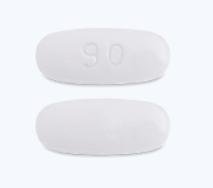Deferasirox Disease Interactions
There are 6 disease interactions with deferasirox.
- Bone marrow suppression
- Dermatologic toxicities
- Hepatic impairment
- Renal dysfunction
- Auditory and ocular abnormalities
- GI complication
Deferasirox (applies to deferasirox) bone marrow suppression
Major Potential Hazard, Moderate plausibility. Applicable conditions: Immunodeficiency, Thrombocytopenia
The use of deferasirox is contraindicated in patients with platelet counts below 50 x 109/L. Cytopenias, worsening anemia, and thrombocytopenia, including fatal events, have been reported in patients treated with deferasirox. Preexisting hematologic disorders may increase this risk. It is recommended to monitor blood counts in all patients and to interrupt treatment in patients who develop cytopenias until the cause of the cytopenia has been determined.
References
- "Product Information. Exjade (deferasirox)." Novartis Pharmaceuticals (2005):
Deferasirox (applies to deferasirox) dermatologic toxicities
Major Potential Hazard, Moderate plausibility. Applicable conditions: Dermatitis - Drug-Induced
Fatal cases of severe cutaneous reactions, including Stevens-Johnson syndrome (SJS), toxic epidermal necrolysis (TEN), and erythema multiforme have occurred in patients treated with deferasirox. The risk of other skin reactions cannot be excluded. It is recommended that if SJS or TEN is suspected to interrupt therapy until the etiology of the reaction has been determined, and if SJS or TEN is confirmed to permanently discontinue treatment with deferasirox. Monitor patients for the development of these severe cutaneous reactions, discontinue deferasirox if clinically appropriate and do not reintroduce therapy. For severe cases of rash, interrupt treatment and consider reintroducing therapy after resolution of the rash at a lower dose with dose escalation as appropriate.
References
- "Product Information. Exjade (deferasirox)." Novartis Pharmaceuticals (2005):
Deferasirox (applies to deferasirox) hepatic impairment
Major Potential Hazard, Moderate plausibility. Applicable conditions: Liver Disease
The use of deferasirox should be avoided in patients with severe hepatic impairment. The starting dose of deferasirox should be reduced by 50% in patients with moderate hepatic impairment. It is recommended to measure serum transaminases and bilirubin in all patients prior to initiating treatment, every 2 weeks during the first month, and at least monthly or more frequently as clinically appropriate. Closely monitor patients with mild or moderate hepatic impairment for efficacy and adverse reactions that may require dose titration.
References
- "Product Information. Exjade (deferasirox)." Novartis Pharmaceuticals (2005):
Deferasirox (applies to deferasirox) renal dysfunction
Major Potential Hazard, Moderate plausibility.
The use of deferasirox is contraindicated in patients with serum creatinine greater than two times the age-appropriate upper limit of normal or creatinine clearance less than 40 mL/min. The starting dose of deferasirox should be reduced by 50% in patients with creatine clearance 40 to 60 mL/min. It is recommended to measure serum creatine and calculate clearance in duplicate prior to initiating treatment in all patients and monitor renal function at least monthly or more frequently as clinically appropriate. Consider dose reduction, interruption, or discontinuation of deferasirox based on increases in serum creatinine.
References
- "Product Information. Exjade (deferasirox)." Novartis Pharmaceuticals (2005):
Deferasirox (applies to deferasirox) auditory and ocular abnormalities
Moderate Potential Hazard, Moderate plausibility. Applicable conditions: Hearing Loss, Visual Defect/Disturbance
Auditory disturbances (high-frequency hearing loss, decreased hearing), and ocular disturbances (lens opacities, cataracts, elevations in intraocular pressure, and retinal disorders) have been reported in patients using deferasirox. It is recommended to perform auditory and ophthalmic testing (including slit lamp examinations and dilated fundoscopy) before starting therapy with deferasirox and thereafter as clinically indicated. If disturbances are noted, consider dose reduction or interruption if appropriate.
References
- "Product Information. Exjade (deferasirox)." Novartis Pharmaceuticals (2005):
Deferasirox (applies to deferasirox) GI complication
Moderate Potential Hazard, Moderate plausibility. Applicable conditions: Thrombocytopenia, Esophageal Ulceration with Bleeding
Gastrointestinal hemorrhage, ulcerations, perforations, including deaths have been documented in patients using deferasirox, especially in elderly patients who had advanced hematologic malignancies and/or low platelet counts. The risk of gastrointestinal hemorrhage may be increased when administering deferasirox in combination with drugs that have ulcerogenic or hemorrhagic potential, such as nonsteroidal anti-inflammatory drugs (NSAIDs), corticosteroids, oral bisphosphonates, or anticoagulants. It is recommended to monitor patients and discontinue therapy for suspected GI ulceration or hemorrhage. Care is recommended when using this agent in patients at risk of GI complications.
References
- "Product Information. Exjade (deferasirox)." Novartis Pharmaceuticals (2005):
Deferasirox drug interactions
There are 584 drug interactions with deferasirox.
Deferasirox alcohol/food interactions
There are 2 alcohol/food interactions with deferasirox.
More about deferasirox
- deferasirox consumer information
- Check interactions
- Compare alternatives
- Pricing & coupons
- Reviews (4)
- Drug images
- Side effects
- Dosage information
- During pregnancy
- Drug class: chelating agents
- Breastfeeding
- En español
Related treatment guides
Drug Interaction Classification
| Highly clinically significant. Avoid combinations; the risk of the interaction outweighs the benefit. | |
| Moderately clinically significant. Usually avoid combinations; use it only under special circumstances. | |
| Minimally clinically significant. Minimize risk; assess risk and consider an alternative drug, take steps to circumvent the interaction risk and/or institute a monitoring plan. | |
| No interaction information available. |
Further information
Always consult your healthcare provider to ensure the information displayed on this page applies to your personal circumstances.


